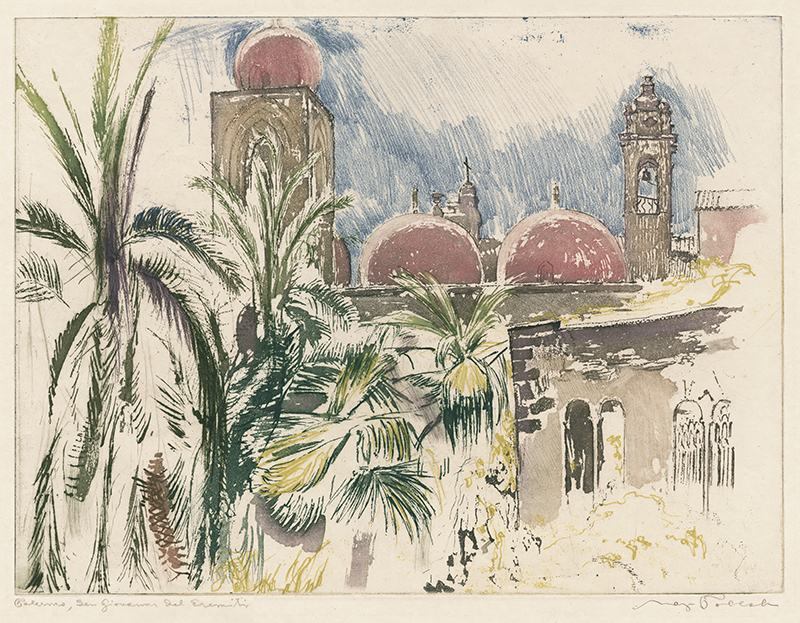Palermo, San Giovanni del Eremiti is an etching and aquatint with softground etching printed in colors by Czech-born artist Max Pollak. It was created about 1932 and is pencil signed and titled in the lower margin.
Pollak’s pencil annotation along the lower sheet edge “printed a. 6” suggests a very tiny edition. Palermo, San Giovanni del Eremiti was printed by the artist on an ivory simile vellum and the platemark measures 11-3/4 x 15-3/4 inches.
In Palermo, San Giovanni del Eremiti, Pollak depicts the bell tower and the bright red hemispherical domes of the twelfth century Catholic church situated in Palmero, the capital of the Italian island of Sicily. The church was rebuilt in 1132 according to the canons of Sicilian-Norman architecture. It is a Romanesque church and externally resembles oriental buildings. Since 2015, the church has been part of the World Heritage Site (UNESCO) in the "Arab-Norman itinerary of Palermo, Cefalù and Monreale."
Max Pollak, painter and printmaker, was born in Prague, Czechoslovakia in 1886. He was raised in Vienna and, in 1902, he entered the Vienna Academy of Art where he studied under William Unger and Ferdinand Schmutzer. In 1912, Pollak traveled to Italy, France, and Holland to study and paint. During the First World War, he was appointed painter of the Austrian Army.
He immigrated to the United States in 1927, living for a time on the east coast where he produced a series of color aquatints of New York, Cincinnati, and Detroit. His first exhibition was at the 57th Street Art Gallery in New York and he was commissioned by Theodore Dreiser in 1929 to illustrate his book, My City. In 1938, Pollak and his wife, Friedl, moved to San Francisco, California. Pollak was inspired by his new city and its environs and produced beautiful views of San Francisco Bay Area. Later travels included trips to Mexico and Guatemala.
Max Pollak was a member of the Chicago Society of Etchers and the California Society of Etchers. His work is represented in the collections of the Magnes Collection of Jewish Art and Life, Berkeley, California; the Jordan Schnitzer Museum of Art, University of Oregon, Eugene; the British Museum, London; the Metropolitan Museum of Art and the New York Public Library, New York; the Oakland Museum of California Art; the Fine Arts Museums of San Francisco, California; and the Smithsonian American Art Museum, Washington, D.C.



